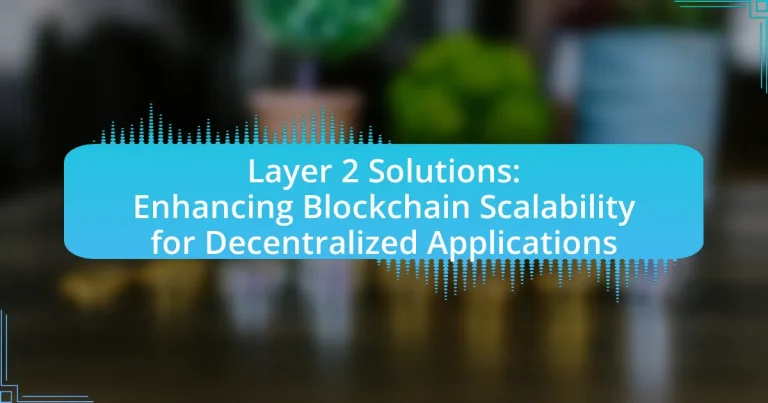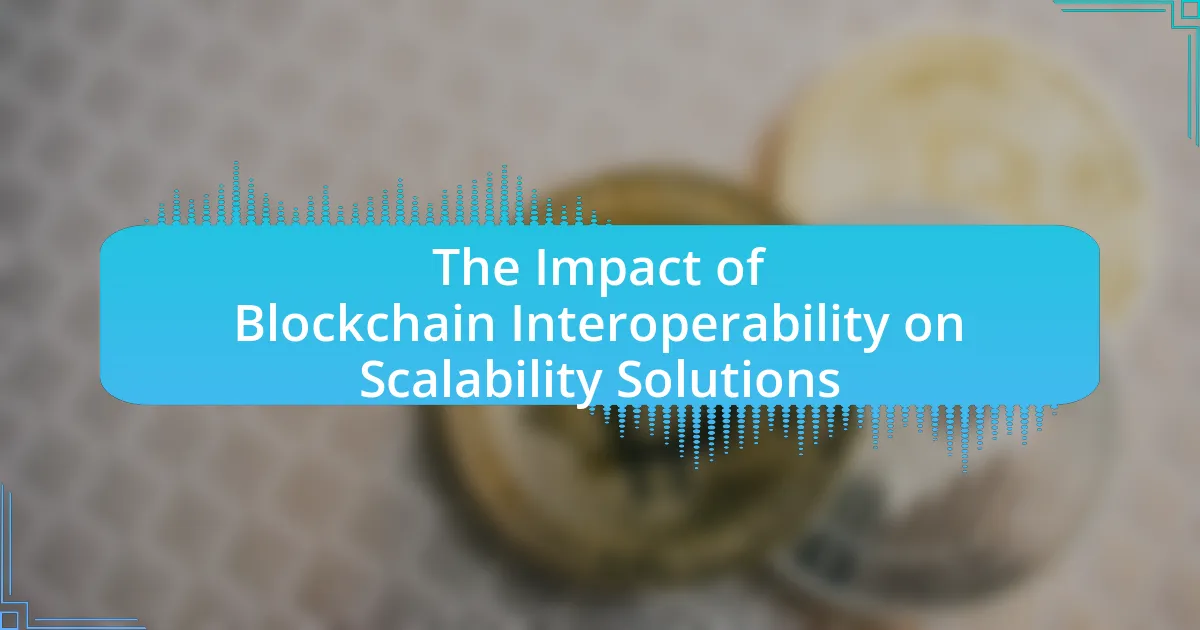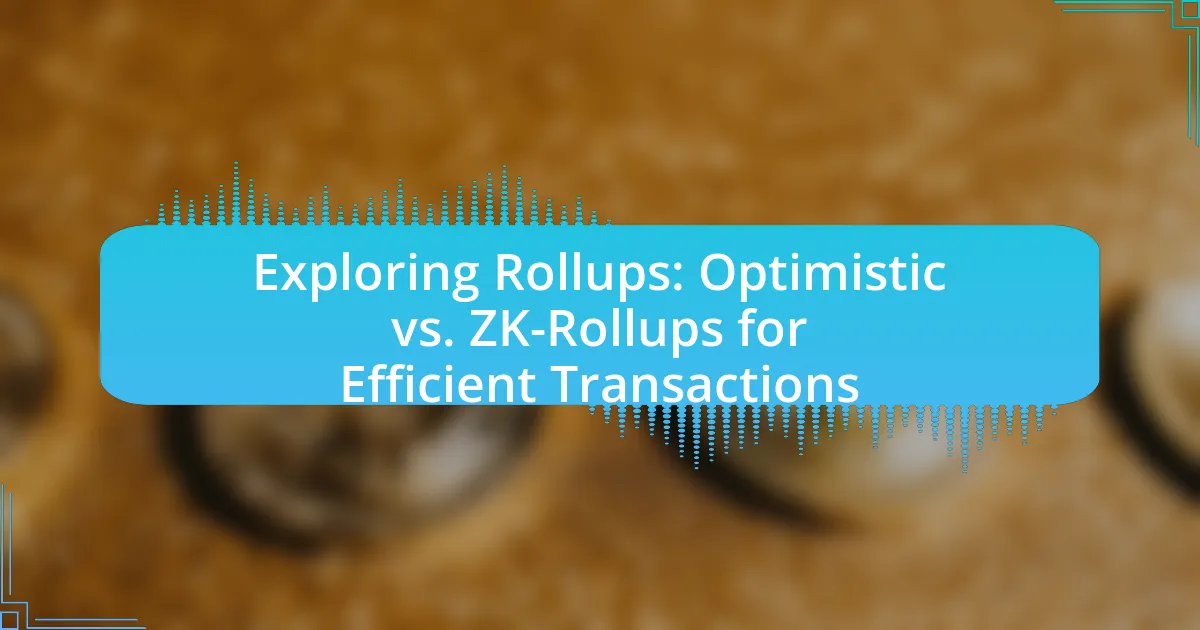Layer 2 solutions are protocols designed to enhance the scalability and transaction throughput of existing blockchain networks, such as Bitcoin and Ethereum. These solutions, including the Lightning Network and Optimistic Rollups, facilitate faster and cheaper transactions by processing them off the main blockchain while maintaining its security. The article explores how Layer 2 solutions improve scalability, enhance user experience, and address challenges faced by decentralized applications, such as high transaction costs and slow processing times. It also discusses various types of Layer 2 solutions, including state channels, sidechains, and rollups, along with their advantages, limitations, and security implications. Additionally, the article outlines best practices for developers implementing these solutions and the common challenges they may encounter.
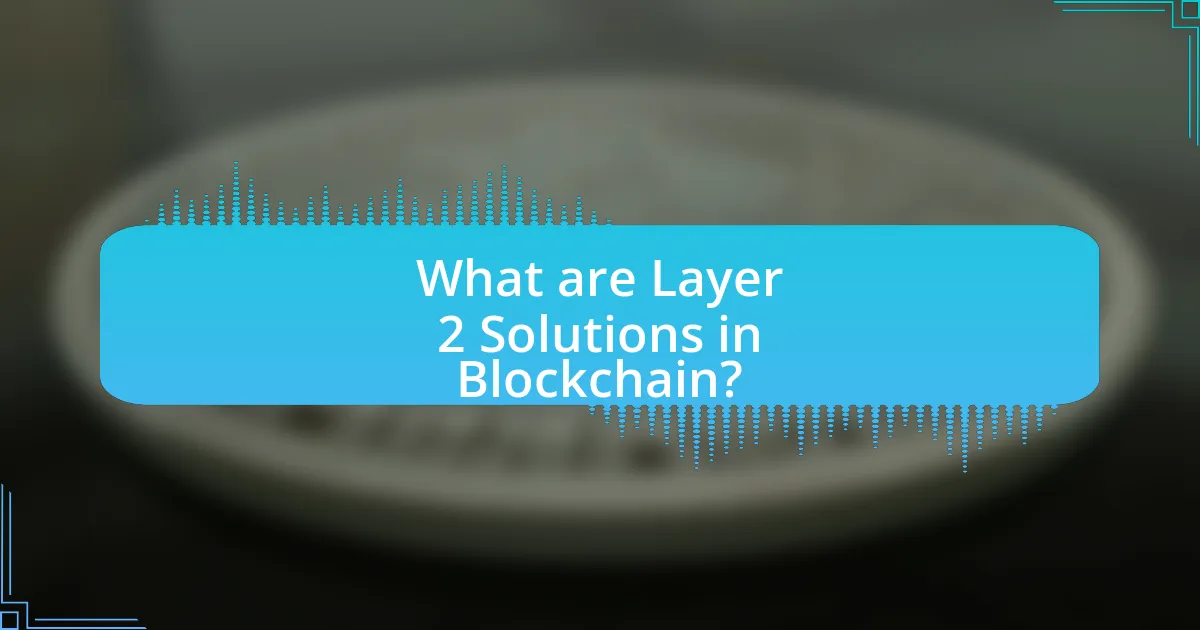
What are Layer 2 Solutions in Blockchain?
Layer 2 solutions in blockchain are protocols built on top of existing blockchain networks to enhance scalability and transaction throughput. These solutions, such as the Lightning Network for Bitcoin and Optimistic Rollups for Ethereum, enable faster and cheaper transactions by processing them off the main blockchain while still leveraging its security. For instance, the Lightning Network allows thousands of transactions per second by creating off-chain payment channels, significantly reducing congestion on the Bitcoin network. This approach addresses the limitations of base layer blockchains, which often struggle with high transaction volumes and slow confirmation times.
How do Layer 2 Solutions enhance scalability?
Layer 2 solutions enhance scalability by processing transactions off the main blockchain, thereby reducing congestion and increasing throughput. These solutions, such as state channels and rollups, allow multiple transactions to be bundled together and settled in a single on-chain transaction, significantly lowering the load on the primary network. For instance, Ethereum’s rollups can increase transaction capacity by up to 100 times compared to the base layer, as they aggregate numerous transactions into one, which is then recorded on the blockchain. This mechanism not only improves transaction speed but also decreases fees, making decentralized applications more efficient and accessible.
What are the key features of Layer 2 Solutions?
Layer 2 solutions primarily enhance blockchain scalability by enabling faster transaction processing and reducing congestion on the main blockchain. These solutions achieve this through mechanisms such as state channels, sidechains, and rollups, which allow transactions to occur off the main chain while still benefiting from its security. For instance, rollups bundle multiple transactions into a single one, significantly increasing throughput and lowering fees. Additionally, Layer 2 solutions often provide improved user experience by enabling instant transactions and lower costs, making decentralized applications more accessible and efficient.
How do Layer 2 Solutions differ from Layer 1 solutions?
Layer 2 solutions differ from Layer 1 solutions primarily in their operational layer and scalability approach. Layer 1 solutions, such as Bitcoin and Ethereum, operate directly on the blockchain and handle all transactions and smart contracts natively, which can lead to congestion and slower transaction speeds. In contrast, Layer 2 solutions, like the Lightning Network for Bitcoin or Optimistic Rollups for Ethereum, function on top of the Layer 1 blockchain, allowing for faster transactions and reduced fees by processing transactions off-chain and then settling them on the main chain. This distinction is crucial as Layer 2 solutions enhance scalability and efficiency without altering the underlying Layer 1 protocol.
Why are Layer 2 Solutions important for decentralized applications?
Layer 2 solutions are important for decentralized applications because they significantly enhance scalability and transaction speed while reducing costs. These solutions, such as state channels and rollups, allow for off-chain processing of transactions, which alleviates congestion on the main blockchain. For instance, Ethereum’s layer 2 solutions can process thousands of transactions per second compared to the main chain’s limitations, which often struggle with high demand. This increased capacity enables decentralized applications to operate efficiently, providing a better user experience and fostering broader adoption.
What challenges do decentralized applications face without Layer 2 Solutions?
Decentralized applications face significant challenges without Layer 2 solutions, primarily including scalability issues, high transaction costs, and slow processing times. Scalability is a critical concern, as most blockchain networks, like Ethereum, can only handle a limited number of transactions per second, leading to congestion during peak usage. For instance, Ethereum’s capacity is around 30 transactions per second, which can result in delays and increased fees when demand surges. High transaction costs arise because users must compete to have their transactions processed, especially during network congestion, making decentralized applications less accessible to users. Additionally, slow processing times hinder user experience, as transactions can take several minutes to confirm, discouraging real-time applications. These challenges collectively limit the functionality and adoption of decentralized applications in a competitive digital landscape.
How do Layer 2 Solutions improve user experience in decentralized applications?
Layer 2 solutions improve user experience in decentralized applications by significantly increasing transaction speed and reducing costs. These solutions, such as state channels and rollups, enable off-chain processing of transactions, which alleviates congestion on the main blockchain. For instance, Ethereum’s Optimistic Rollups can process thousands of transactions per second, compared to the main chain’s limitations, leading to faster confirmations and lower fees. This enhanced efficiency allows users to interact with decentralized applications more seamlessly, fostering greater adoption and satisfaction.
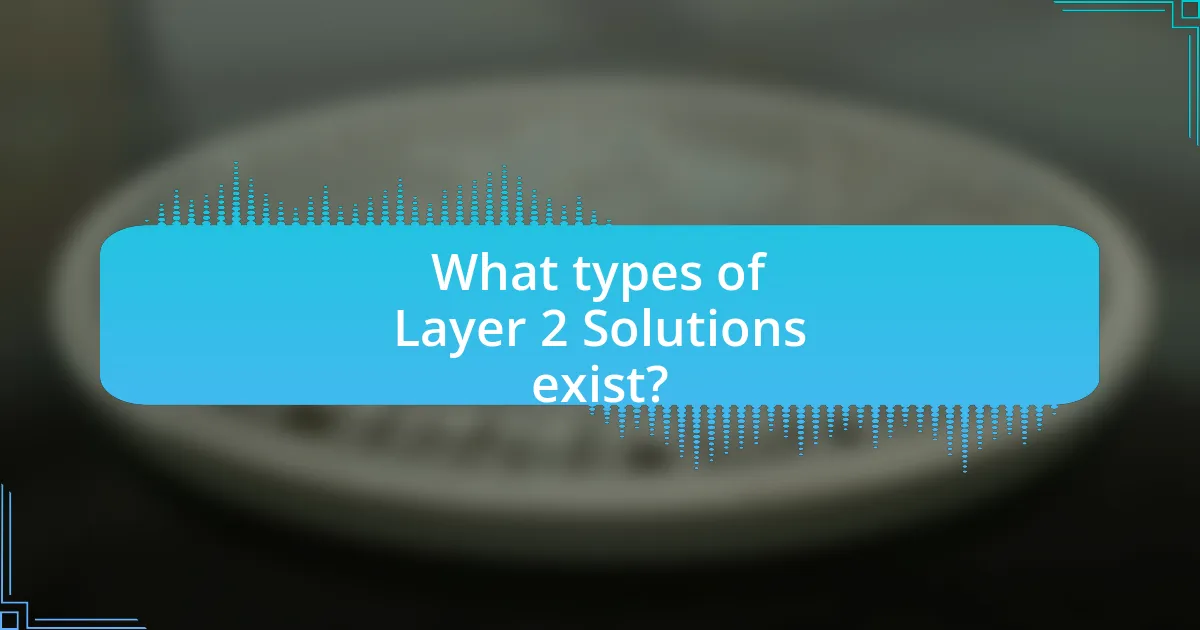
What types of Layer 2 Solutions exist?
There are several types of Layer 2 solutions that enhance blockchain scalability, including state channels, sidechains, rollups, and plasma. State channels allow participants to conduct transactions off-chain while only recording the final state on-chain, significantly reducing congestion. Sidechains operate independently of the main blockchain, enabling assets to be transferred between chains, which alleviates load on the primary network. Rollups bundle multiple transactions into a single one, processing them off-chain and submitting a summary to the main chain, thus improving throughput. Plasma creates smaller child chains that can process transactions independently, allowing for greater scalability while still being anchored to the main blockchain. Each of these solutions addresses scalability challenges by optimizing transaction processing and reducing on-chain load.
How do state channels work as a Layer 2 Solution?
State channels function as a Layer 2 solution by allowing participants to conduct off-chain transactions while maintaining the security and finality of the underlying blockchain. This mechanism enables users to create a private channel where they can execute multiple transactions without needing to record each one on the main blockchain, significantly reducing congestion and fees.
For example, in Ethereum, state channels utilize smart contracts to lock funds and facilitate interactions between parties. Once the transactions are completed, only the final state is submitted to the blockchain, ensuring that the process is efficient and scalable. This approach has been validated by implementations such as the Lightning Network for Bitcoin and Raiden Network for Ethereum, which demonstrate enhanced transaction throughput and lower latency compared to on-chain transactions.
What are the advantages of using state channels?
State channels offer significant advantages for blockchain scalability, primarily by enabling off-chain transactions that reduce congestion on the main blockchain. This mechanism allows participants to conduct multiple transactions without the need for each one to be recorded on the blockchain, thereby minimizing transaction fees and increasing speed. For instance, state channels can facilitate instant payments and interactions in decentralized applications, as they only require the final state to be submitted to the blockchain, which conserves resources and enhances throughput. Additionally, state channels enhance privacy since transaction details remain off-chain, protecting user data from public exposure. These benefits collectively contribute to a more efficient and user-friendly blockchain ecosystem.
What limitations do state channels have?
State channels have several limitations, including the requirement for participants to be online and actively engaged for the channel to function, which can hinder accessibility. Additionally, state channels are primarily effective for specific types of transactions, such as those that are frequent and low-value, limiting their applicability for larger or more complex transactions. Furthermore, the need for a trusted setup and potential centralization risks can undermine the decentralized nature of blockchain technology. These limitations restrict the overall scalability and usability of state channels in various decentralized applications.
What role do sidechains play in Layer 2 Solutions?
Sidechains serve as a crucial component in Layer 2 solutions by enabling the transfer of assets and data between different blockchains while alleviating congestion on the main chain. They operate independently from the primary blockchain, allowing for faster transactions and reduced fees, which enhances overall scalability. For instance, sidechains can process transactions in parallel to the main chain, thereby increasing throughput and enabling decentralized applications to function more efficiently. This functionality is evidenced by projects like Liquid Network, which allows Bitcoin transactions to occur on a sidechain, demonstrating improved transaction speeds and lower costs compared to the Bitcoin main chain.
How do sidechains enhance blockchain functionality?
Sidechains enhance blockchain functionality by allowing for the execution of transactions and smart contracts independently from the main blockchain, thereby improving scalability and reducing congestion. This separation enables developers to create specialized environments for specific applications, which can operate with different consensus mechanisms or features tailored to their needs. For instance, sidechains can facilitate faster transaction speeds and lower fees, as they are not burdened by the main chain’s traffic. Additionally, sidechains can enhance security by isolating potential vulnerabilities, allowing for experimentation without risking the integrity of the primary blockchain. This modular approach has been exemplified by projects like Liquid Network, which provides faster Bitcoin transactions while maintaining a connection to the Bitcoin blockchain.
What are the security implications of using sidechains?
Using sidechains introduces specific security implications, primarily related to the trust model and potential vulnerabilities. Sidechains operate independently from the main blockchain, which means that their security is not inherently guaranteed by the main chain’s consensus mechanism. This independence can lead to risks such as inadequate security protocols, making them susceptible to attacks like double-spending or hacking if not properly secured.
For instance, if a sidechain employs a less robust consensus algorithm than the main blockchain, it may be easier for malicious actors to compromise it. Additionally, the process of transferring assets between the main chain and sidechain can create vulnerabilities, as these transfers often rely on mechanisms that may not be as secure as the main blockchain’s.
Research indicates that sidechains can enhance scalability but must be designed with strong security measures to mitigate these risks. The 2020 paper “Sidechains: A New Paradigm for Blockchain Scalability” by authors from the University of Cambridge highlights that while sidechains can improve transaction throughput, their security must be rigorously evaluated to prevent potential exploits.
What are rollups and how do they function?
Rollups are Layer 2 scaling solutions that aggregate multiple transactions into a single batch, which is then processed on the main blockchain. This function allows for increased transaction throughput and reduced fees by minimizing the data that needs to be recorded on the base layer. Rollups operate by executing transactions off-chain while maintaining the security of the main blockchain through cryptographic proofs. For instance, Optimistic Rollups assume transactions are valid and only check for fraud when challenged, while ZK-Rollups use zero-knowledge proofs to verify the correctness of transactions without revealing the underlying data. This approach significantly enhances scalability, allowing decentralized applications to handle a higher volume of transactions efficiently.
What are the different types of rollups?
The different types of rollups are Optimistic Rollups and Zero-Knowledge Rollups (ZK-Rollups). Optimistic Rollups assume transactions are valid by default and only check for fraud when challenged, which allows for faster processing but requires a dispute resolution mechanism. In contrast, ZK-Rollups use cryptographic proofs to validate transactions off-chain, ensuring that only valid transactions are added to the blockchain, which enhances security and scalability. Both types significantly improve transaction throughput and reduce costs on the main blockchain, making them essential for scaling decentralized applications.
How do rollups impact transaction costs and speed?
Rollups significantly reduce transaction costs and increase speed by aggregating multiple transactions into a single batch before submitting them to the main blockchain. This aggregation minimizes the amount of data processed on-chain, leading to lower fees per transaction. For instance, Ethereum rollups can achieve transaction costs as low as a few cents compared to the typical costs of several dollars on the main chain. Additionally, rollups enhance speed by processing transactions off-chain, allowing for thousands of transactions per second, which is a substantial improvement over the main blockchain’s capacity. This efficiency is evidenced by the fact that optimistic rollups can handle up to 2,000 transactions per second, compared to Ethereum’s base layer, which averages around 30 transactions per second.
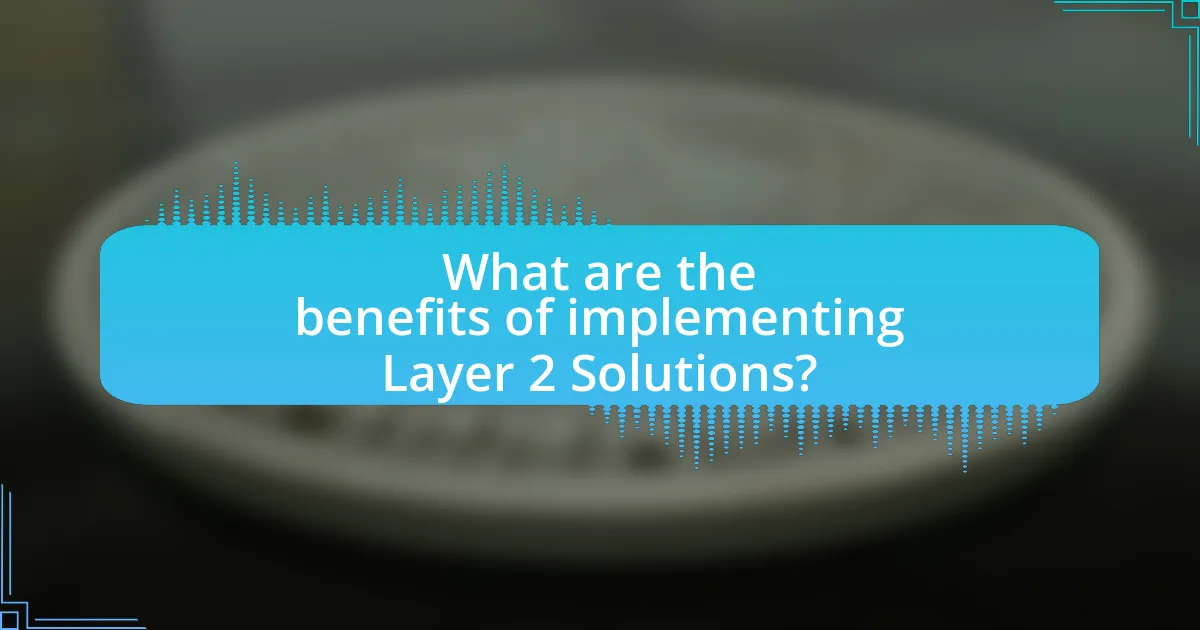
What are the benefits of implementing Layer 2 Solutions?
Implementing Layer 2 Solutions significantly enhances blockchain scalability and transaction speed. These solutions, such as state channels and rollups, allow for off-chain processing of transactions, which reduces the load on the main blockchain network. For instance, Ethereum’s rollups can process thousands of transactions per second, compared to the main chain’s limitation of around 30 transactions per second. This increased throughput leads to lower transaction fees and faster confirmation times, making decentralized applications more efficient and user-friendly. Additionally, Layer 2 Solutions contribute to improved security by maintaining the underlying blockchain’s integrity while enabling greater scalability.
How do Layer 2 Solutions reduce transaction fees?
Layer 2 solutions reduce transaction fees by processing transactions off the main blockchain, thereby alleviating congestion and lowering costs. These solutions, such as state channels and rollups, aggregate multiple transactions into a single batch before submitting them to the main chain, which minimizes the amount of data that needs to be recorded on-chain. For instance, Ethereum’s Optimistic Rollups can reduce fees significantly by allowing hundreds of transactions to be bundled together, resulting in lower per-transaction costs. This method not only enhances scalability but also makes transactions more economical for users.
What factors contribute to lower fees in Layer 2 Solutions?
Lower fees in Layer 2 Solutions are primarily driven by reduced transaction congestion and improved scalability. Layer 2 Solutions, such as state channels and rollups, process transactions off the main blockchain, significantly decreasing the load on the primary network. This offloading allows for a higher throughput of transactions, which in turn lowers the fees associated with each transaction. For instance, rollups can bundle multiple transactions into a single one, minimizing the number of on-chain transactions required and thus reducing costs. Additionally, the competition among Layer 2 networks encourages lower fees as providers strive to attract users by offering more economical transaction options.
How do reduced fees affect user adoption?
Reduced fees significantly enhance user adoption by lowering the financial barrier to entry for utilizing decentralized applications. When transaction costs decrease, more users are likely to engage with the platform, as evidenced by studies showing that platforms with lower fees experience higher transaction volumes. For instance, Ethereum’s Layer 2 solutions, such as Optimism and Arbitrum, have demonstrated increased user activity and transaction counts following fee reductions, indicating a direct correlation between lower costs and user engagement. This trend highlights that affordability is a critical factor in attracting and retaining users in blockchain ecosystems.
What scalability improvements can be expected from Layer 2 Solutions?
Layer 2 solutions can significantly enhance blockchain scalability by enabling faster transaction processing and reducing congestion on the main blockchain. These solutions, such as state channels and rollups, allow transactions to occur off-chain while still leveraging the security of the main chain. For instance, Ethereum’s rollups can increase throughput to thousands of transactions per second, compared to the main chain’s limit of around 30 transactions per second. This improvement is evidenced by projects like Optimistic Rollups and zk-Rollups, which have demonstrated the ability to bundle multiple transactions into a single on-chain transaction, thereby optimizing resource use and lowering fees.
How do Layer 2 Solutions increase transaction throughput?
Layer 2 solutions increase transaction throughput by processing transactions off the main blockchain, thereby reducing congestion and enabling faster confirmations. These solutions, such as state channels and rollups, allow multiple transactions to be bundled together and settled in a single on-chain transaction, significantly increasing the number of transactions that can be handled per second. For example, Ethereum’s Optimistic Rollups can potentially increase throughput to thousands of transactions per second compared to the base layer’s limitations of around 15 transactions per second. This offloading of transaction processing alleviates the burden on the main blockchain, enhancing overall scalability and efficiency.
What is the impact of scalability on network congestion?
Scalability directly reduces network congestion by enabling systems to handle increased transaction volumes without performance degradation. When a blockchain network implements scalability solutions, such as Layer 2 protocols, it can process more transactions simultaneously, thereby alleviating bottlenecks that typically occur during peak usage times. For instance, Ethereum’s implementation of Layer 2 solutions like Optimistic Rollups has demonstrated the ability to increase transaction throughput significantly, reducing congestion and improving user experience. This is evidenced by the fact that Layer 2 solutions can achieve thousands of transactions per second compared to Ethereum’s base layer, which processes around 30 transactions per second.
What are the potential drawbacks of Layer 2 Solutions?
Layer 2 solutions can introduce several potential drawbacks, including increased complexity, reliance on third-party operators, and potential security vulnerabilities. The complexity arises from the need for additional protocols and mechanisms to manage transactions off-chain, which can lead to integration challenges with existing Layer 1 blockchains. Reliance on third-party operators can create centralization risks, as users may have to trust these entities to manage their transactions effectively. Additionally, security vulnerabilities may emerge due to the interaction between Layer 2 and Layer 1, where flaws in the Layer 2 protocol could expose users to risks such as loss of funds or transaction manipulation.
What security risks are associated with Layer 2 Solutions?
Layer 2 solutions face several security risks, including potential vulnerabilities to fraud proofs, reliance on the security of the underlying Layer 1 blockchain, and risks associated with centralized components. Fraud proofs can be exploited if not properly implemented, allowing malicious actors to manipulate transactions. Additionally, if the Layer 1 blockchain experiences a security breach, the integrity of the Layer 2 solution may be compromised. Centralized components, such as operators or validators, can introduce single points of failure, making the system susceptible to attacks or failures. These risks highlight the importance of robust security measures in the design and implementation of Layer 2 solutions.
How do interoperability issues affect Layer 2 Solutions?
Interoperability issues significantly hinder the effectiveness of Layer 2 solutions by limiting their ability to communicate and transact across different blockchain networks. These solutions, designed to enhance scalability and reduce congestion on primary blockchains, often rely on seamless interactions with various Layer 1 chains and other Layer 2 protocols. When interoperability is compromised, it can lead to fragmented ecosystems where assets and data cannot be easily transferred or utilized across platforms, ultimately reducing the utility and adoption of Layer 2 solutions. For instance, if a Layer 2 solution cannot interact with multiple Layer 1 blockchains, users may face challenges in moving assets, which can deter developers from building applications that leverage these solutions, thereby stifling innovation and scalability in decentralized applications.
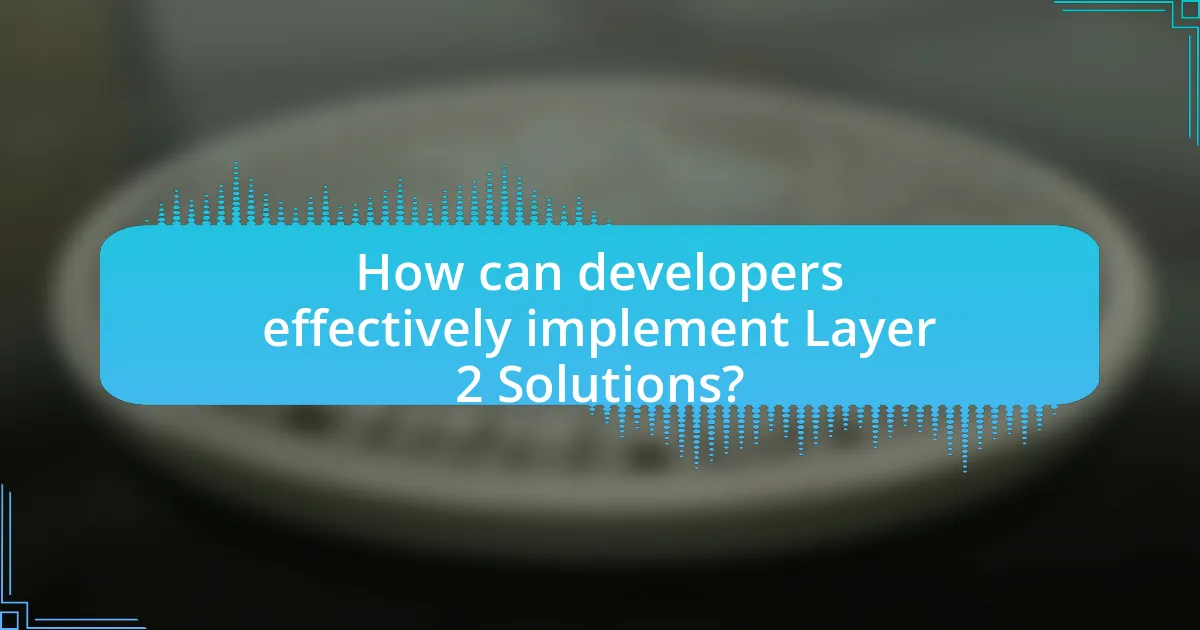
How can developers effectively implement Layer 2 Solutions?
Developers can effectively implement Layer 2 solutions by utilizing protocols such as state channels, sidechains, and rollups to enhance transaction throughput and reduce costs. These methods allow for off-chain processing of transactions, which alleviates congestion on the main blockchain. For instance, state channels enable participants to conduct multiple transactions off-chain and only settle the final state on-chain, significantly decreasing the number of on-chain transactions. Additionally, rollups bundle multiple transactions into a single one, optimizing data storage and reducing fees. The Ethereum network has seen successful implementations of these solutions, with projects like Optimistic Rollups and zk-Rollups demonstrating improved scalability and efficiency.
What best practices should developers follow when integrating Layer 2 Solutions?
Developers should prioritize security, user experience, and interoperability when integrating Layer 2 solutions. Security is crucial; developers must conduct thorough audits and testing to identify vulnerabilities, as evidenced by the significant losses from hacks in the DeFi space, which totaled over $1.3 billion in 2021 alone. User experience should be enhanced by ensuring seamless transitions between Layer 1 and Layer 2, minimizing latency, and providing clear documentation. Interoperability is essential for broader adoption; developers should design solutions that can easily interact with various Layer 1 blockchains and other Layer 2 networks, as demonstrated by the growing trend of cross-chain compatibility in successful projects.
How can developers ensure security during implementation?
Developers can ensure security during implementation by adopting best practices such as conducting thorough code reviews, implementing robust authentication mechanisms, and utilizing encryption for data protection. Code reviews help identify vulnerabilities early in the development process, while strong authentication methods, such as multi-factor authentication, prevent unauthorized access. Additionally, encryption safeguards sensitive data both in transit and at rest, reducing the risk of data breaches. According to a study by the National Institute of Standards and Technology, implementing these security measures significantly decreases the likelihood of successful cyberattacks, thereby enhancing the overall security posture of decentralized applications built on Layer 2 solutions.
What tools and resources are available for developers working with Layer 2 Solutions?
Developers working with Layer 2 Solutions have access to various tools and resources that facilitate the creation and deployment of scalable blockchain applications. Key tools include frameworks like Optimism and Arbitrum, which provide infrastructure for building on Ethereum’s Layer 2. Additionally, development environments such as Hardhat and Truffle support smart contract development and testing. Resources like the Ethereum Foundation’s documentation and community forums offer guidance and support. Furthermore, libraries such as ethers.js and web3.js enable seamless interaction with Layer 2 networks. These tools and resources collectively enhance the efficiency and effectiveness of developing Layer 2 solutions.
What common challenges do developers face with Layer 2 Solutions?
Developers face several common challenges with Layer 2 Solutions, including complexity in integration, security concerns, and interoperability issues. The complexity arises from the need to understand both Layer 1 and Layer 2 protocols, which can lead to increased development time and potential for errors. Security concerns stem from the fact that Layer 2 solutions may introduce new attack vectors, as seen in cases like the Optimistic Rollup vulnerabilities. Interoperability issues occur when different Layer 2 solutions do not communicate effectively with each other or with Layer 1, complicating user experience and application functionality. These challenges highlight the need for robust frameworks and tools to facilitate smoother development processes in Layer 2 environments.
How can developers troubleshoot issues related to Layer 2 Solutions?
Developers can troubleshoot issues related to Layer 2 Solutions by systematically analyzing transaction failures, monitoring network performance, and reviewing smart contract interactions. Analyzing transaction failures involves checking error messages and logs to identify specific issues, such as gas limits or incorrect parameters. Monitoring network performance includes assessing latency, throughput, and congestion levels to pinpoint bottlenecks. Reviewing smart contract interactions ensures that the contracts are functioning as intended and that there are no logical errors or vulnerabilities. These methods are supported by tools like block explorers and analytics platforms that provide real-time data and insights into Layer 2 operations.
What strategies can be employed to overcome integration challenges?
To overcome integration challenges in Layer 2 solutions for blockchain scalability, employing strategies such as standardized protocols, robust testing frameworks, and effective communication among stakeholders is essential. Standardized protocols facilitate interoperability between different Layer 2 solutions and the main blockchain, ensuring seamless integration. Robust testing frameworks allow developers to identify and resolve issues before deployment, minimizing integration risks. Effective communication among stakeholders, including developers, users, and businesses, fosters collaboration and alignment on integration goals, which is critical for successful implementation. These strategies are supported by industry practices that emphasize the importance of interoperability and stakeholder engagement in technology integration.












